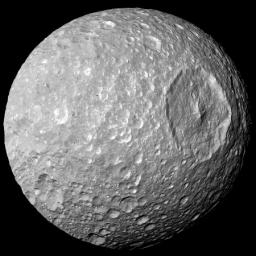Saturn's tiny moon Mimas may have sub-surface liquid ocean
 Mimas, one of Saturn's smaller satellites, may seem a little dull... An icy moon that's just 246 miles wide and whose most distinctive feature is the 88-mile-wide Herschel crater - a giant Cyclops-like indentation that makes the moon resemble the planet-obliterating superweapon from "Star Wars" that's known as the Death Star. But the moon may hold a special secret of its own. A stronger than expected rotational wobble points to one of two intriguing scenarios: Mimas either has an irregularly shaped core or has an ocean buried underneath its icy surface. "Something else has to be going on inside." The findings, described in the journal Science, shed new light on a mysterious but often-overlooked moon that could hold clues to its early formation.
Mimas, one of Saturn's smaller satellites, may seem a little dull... An icy moon that's just 246 miles wide and whose most distinctive feature is the 88-mile-wide Herschel crater - a giant Cyclops-like indentation that makes the moon resemble the planet-obliterating superweapon from "Star Wars" that's known as the Death Star. But the moon may hold a special secret of its own. A stronger than expected rotational wobble points to one of two intriguing scenarios: Mimas either has an irregularly shaped core or has an ocean buried underneath its icy surface. "Something else has to be going on inside." The findings, described in the journal Science, shed new light on a mysterious but often-overlooked moon that could hold clues to its early formation.Other scientists say it's unlikely Mimas has such an interesting interior and think the wobble can be explained more simply. One problem is that Mimas's ancient, heavily cratered surface shows no signs that water has ever touched it-unlike, say, the freshly Zamboni-ed ice skating rink of Europa. That same result could be achieved with irregular gradations in the density of rock, ice, and pore space. The detected wobble could also have been knocked into existence by something that has nothing to do with the moon's interior: a comet impact.